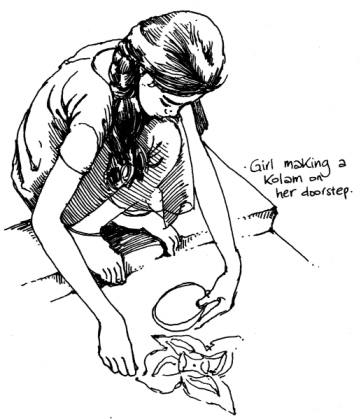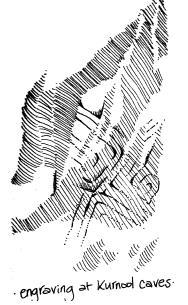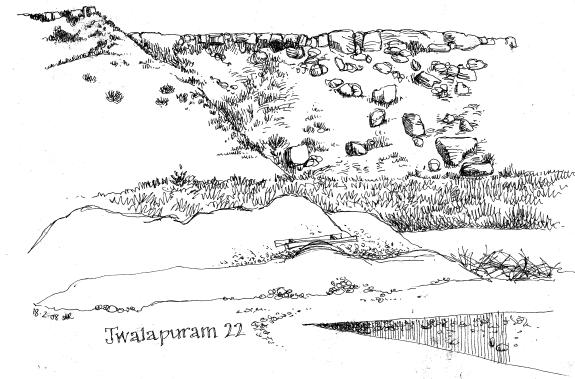The Incredible Human Journey (14 page)
Read The Incredible Human Journey Online
Authors: Alice Roberts

So Arabia is still a bit of a mystery. But once the modern humans had expanded out of Africa, they continued expanding, with a wave of colonisation pushing east and perhaps even reaching Australia, before modern humans made their way northwards into Europe. Climate change may have pushed modern humans to the coast of South and East Africa, forcing them to adapt to this habitat and diversify their subsistence, but once they had learned to make use of coastal resources, the coast would provide them with a benign habitat that stayed relatively stable compared with inland environments, through the fluctuating climate of the Pleistocene.
7
The next stage of my journey would be to head east and try to pick up the traces of the migration along the coastline of the Indian Ocean.
2. Footprints of the Ancestors:
From India to Australia


Archaeology in the Ashes: Jwalapuram, India
Around 74,000 years ago a massive volcano erupted on what is now Sumatra.
1
It was the greatest volcanic eruption of the last two million years,
2
and the biggest that the human species has yet experienced: tens of thousands of times larger than any eruption recorded in history. The huge 100km-wide crater left by the eruption is now filled with a massive lake: Lake Toba.
When Toba volcano erupted, there were humans, although not all of them modern, in Africa, Europe and parts of Central and South-East Asia. There were Neanderthals in Europe,
Homo heidelbergensis
in China, and perhaps there were still some
Homo erectus
in South-East Asia. Anatomically modern humans were in Africa, and probably in the Arabian Peninsula, too. But had they reached India by that time?
The first part of my journey would take me closer to Toba, not to Sumatra but to India, to Jwalapuram in the Kurnool district of Andhra Pradesh, where an archaeological excavation through the Toba ash layer was under way. When Toba erupted, it spewed out massive clouds of heated ash, and this ash has been found deep beneath the seabeds of the South China Sea and the Indian Ocean – as well as on the Indian subcontinent (India, Pakistan, Bangladesh, Sri Lanka, Bhutan and Nepal), more than 3000km away from the volcano. From the pattern of dispersal of the ash it seems likely that the eruption occurred during the summer monsoon season, when southerly winds would have blown the ash northwards towards the continent.
3
There is still some uncertainty about the effect of the Toba super-eruption on climate and its impact on plants and animals – including humans – as well as controversy over whether or not humans had reached India by that time.
2
These unanswered questions explain why the archaeologists are still there, in that hot and dusty district of central India, digging through the ash for more clues, more pieces of the puzzle. So, having flown into Chennai and on to Bangalore, I caught the train to Nandyal in Andhra Pradesh to meet archaeologists Mike Petraglia (Cambridge University) and Ravi Korisettar (Karnatak University), who head up the international team working on the Toba ash layers at Jwalapuram.
We left Nandyal early the next morning, and I shared a jeep with Ravi Korisettar. Our fearless driver thought nothing of overtaking – or undertaking – on bends or hills, speeding up whenever confronted with people, chickens, dogs or cows on the road. The journey took about an hour and a half, along potholed roads.
As we drew near to the site the landscape changed, and the dry, dusty fields and brickworks around Nandyal gave way to a lusher landscape of paddy fields, where flocks of egrets wheeled then settled in regimental lines. We drove along roads lined with neem trees, then turned off the tarmac road on to a track, which wound its way through the small village of Jwalapuram and further on into the Jurrera River valley, framed by limestone escarpments topped with quartzite boulders. The slopes were covered in scrubby bushes, and some massive limestone boulders had tumbled down, forming readymade rockshelters. The Jurrera River was penned behind a dam, with some small streams trickling through to irrigate the paddy fields at the edges of the basin.
Ravi told me that the archaeological site near Jwalapuram had revealed evidence of ancient humans living around the shores of a lake. Back then, in the Pleistocene, a high water table would have meant that springs gushed from the limestone hills all year round, and the floor of the basin would have contained a lake, fed by the springs and by monsoon rains. ‘As a result of these perennial fresh water and spring water resources, this region would have been covered with lush green vegetation, wooded forests, a diverse variety of plant foods. This would have attracted animals, and then humans would have been drawn to this basin because of fresh water, plant food and animal food resources. And, above all, what we have here are ideal rocks – limestone, quartzite and chert – for manufacturing a variety of stone tools.’
Ravi suggested that the basin would have been such a great place to live that the hunter-gatherers could have moved around within it, finding plenty of resources, and never really needing to move out.
This is a useful thought to keep in mind as it puts a brake on the idea of anatomically modern humans furiously racing across Asia. It may have been a rapid dispersal in the grand frame of geological time, but on a more human time scale the spread would have been gradual, a wave of advancing colonisation edging east. Behind the wave, hunter-gatherers would have been left, populating the landscape, albeit sparsely.
‘How many people do you think would have been living around the lake here?’ I asked.
‘Prehistoric populations were very small,’ replied Ravi. ‘I suspect there would have been bands of perhaps fifty to a hundred people, living a hunting and gathering, nomadic way of life here.’

The central part of the basin, where we were headed, was very dry and dotted with vicious, thorny acacia bushes.
We saw the clouds of white ash in the air long before we reached the site. The archaeological site was being revealed in part – as well as being destroyed – by mining. And the workers were after not precious metals or gems, but ash. The ancient volcanic ash was being mined, raked and sieved, bagged up, all by hand, and then sent away to be turned into brass-cleaning products. Some of this ash was being shipped back ‘home’ to Indonesia. It was shocking to see people scraping back the hardened ash layer with wooden forks, sending clouds of silicate into the air to be breathed into unprotected lungs: no one was wearing a mask or even covering their nose and mouth. Even more disturbing was that most of the workers were children. The caste system is meant to be a thing of the past, and child labour is illegal, but these low-caste children from the local village did not attend school and were sent out to work instead.
We pulled up just beyond the ash-mining area, where the unmistakable evidence of Palaeolithic archaeologists at work could be seen: a deep, square hole in the ground, with almost impossibly straight edges and perfectly flat and perpendicular sides. We piled out of the jeeps and met Ravi’s collaborator from Cambridge, Dr Mike Petraglia. While Ravi was the epitomy of an Indian professor, reserved and thoughtful, Mike was a zealous American archaeologist with a penchant for ancient and exotic investigations, and was even sporting an Indiana Jonesesque hat. He strode around the landscape, taking me on a guided tour of all that Jwalapuram had to offer.
In a square trench, or Jwalapuram 22 as it was more properly known, excavations were ongoing, and a slender whitish line about 57m below the surface marked the Toba ash layer. Villagers-turned-diggers were carefully trowelling around calcrete lumps, which visiting geologists later pronounced to be infilled termite tunnels, marking the basin floor before the ash fall. The trench was sited where the lake shore would have been before the Toba eruption. The ash layer was subtle there, so Mike took me to the edge of the ash-mining area, where a roughly cut section through the sediments revealed a stonking 2m-deep layer of white ash. Here was Toba ash – and lots of it. It was almost as though someone had walked along the section white-washing everything between shoulder and ankle height. Mike’s team had tested the tephra deposits and confirmed that they were indeed ash layers from the eruption at 74,000 years, called the Youngest Toba Tuff (YTT), as opposed to ash layers produced by much earlier eruptions. They analysed the microstructure of the tephra and found minute volcanic glass shards that were very similar to those seen in other proven YTT deposits in Sumatra.
Ravi explained to me why there were such wide-ranging differences in the thickness of the ash layer across the valley floor. The initial ash fall probably covered the landscape in a layer some 10–15cm deep, like a heavy snowfall. Then, rain – some immediately precipitated by the dust in the atmosphere – would have washed the ash down into the lake. The ash would have gradually settled out on the lake floor, building up into a thick sediment, which explained the thick band in the section where the ash mining was going on. The bottom of the band of ash sat on the red-brown clay of the ancient lake bed. Ravi said that the lake appeared to have dried up soon after the Toba eruption and the ash fall.

What Mike and Ravi were really interested in, though, was not the Toba ash itself, but stone tools that they had found, closely associated with it. But were the toolmakers modern humans or archaic species? Hand axes have been discovered in the vicinity of Jwalapuram (though not associated with the ash), showing that archaic humans had certainly been in the area. And there are many other sites in India with ancient stone tools made by earlier hominins, as well as direct evidence in the form of the ‘Narmada cranium’ of
Homo heidelbergensis
, from between 250,000 and 300,000 years ago.
4
But both archaeologists were convinced that the tools associated with the Toba ash, dating to between 70,000 and 80,000 years ago, were indicative of modern humans.
Back in the ‘lab’ – a hotel room in Nandyal – Mike showed me some of the tools from the excavation. The OSL dates for the layers in which the tools were found ranged from 74,000 years, above the ash, to 78,000, below the ash. There was a Levallois core from below the ash, which had been shaped around the edges prior to flakes being struck off. There was a large selection of flakes that had been knapped from cobbles in just this way, and then carefully chipped or ‘retouched’ to produce serrated edges. Tools like this were probably used as scrapers, perhaps to clean hides or process plant material. These flakes came from layers both above and below the Toba ash. There were also some longer blades, which looked like useful cutting tools, and some pointy, burin-like pieces, from below the ash.
But Mike was particularly excited by a recent find, a tanged point, perhaps the tip of a spear or dart, found in the layer below the ash. There were also some tiny blades, from above the ash, which Mike called ‘microblades’, quite similar to the ones I’d seen at Pinnacle Point in South Africa. As far as Mike was concerned, the tanged point and microblades quite clearly indicated advanced, composite tools – and modern humans. ‘It suggests an African connection – these tanged points are very characteristic of industries being made by modern humans in Africa between ninety and sixty thousand years ago,’ he explained. ‘But our findings are controversial in the sense that we’re finding stone tools that date right back to seventy-eight thousand years. It’s much earlier than people have previously suggested that modern humans had reached India.’
